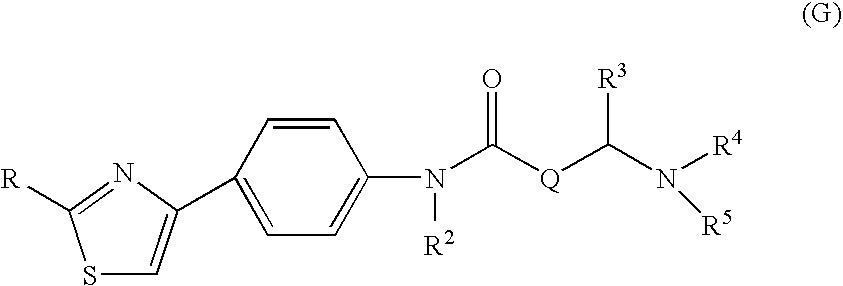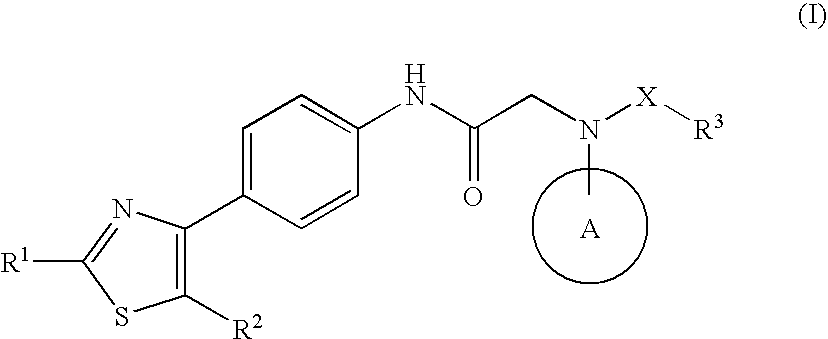Amide derivative
a technology of amide and derivative, applied in the field of new amide derivatives, can solve the problems of not illustratively revealing the anti-vzv activity of these compounds, apprehension about their mutagenicity, and not revealing compounds having good anti-vzv activity
- Summary
- Abstract
- Description
- Claims
- Application Information
AI Technical Summary
Benefits of technology
Problems solved by technology
Method used
Image
Examples
reference example 1
[0090]Potassium carbonate and ethyl bromoacetate were added to DMF solution of aniline and stirred under heating. After adding water and ethyl acetate to the reaction mixture, the organic layer was separated, washed and dried, and then the solvent was evaporated under a reduced pressure to obtain a crude product. This was dissolved in chloroform, mixed with TEA, 4-fluorobenzoyl chloride and dimethylaminopyridine (DMAP) and stirred. After adding 1 M hydrochloric acid to the reaction solution, the organic layer was separated, washed and dried, and then the solvent was evaporated under a reduced pressure. By purifying the thus obtained crude product by a silica gel column chromatography (to be referred to as SCG hereinafter), ethyl [(4-fluorobenzoyl)phenylamino]acetate (colorless oil) was obtained.
reference example 2
[0091]Potassium carbonate and benzyl bromoacetate were added to DMF solution of ethyl (4-aminophenoxy)acetate and stirred under heating. After adding water and ethyl acetate to the reaction mixture, the organic layer was separated, washed and dried, and then the solvent was evaporated under a reduced pressure. Dichloromethane solution of the thus obtained crude product was mixed with TEA, 4-fluorobenzoyl chloride was added dropwise thereto under ice-cooling and then the reaction solution was stirred. After adding 1 M hydrochloric acid to the reaction solution, the organic layer was separated, washed and dried, and then the solvent was evaporated under a reduced pressure. By purifying the thus obtained crude product by SCG, ethyl {4-[benzyloxycarbonylmethyl-(4-fluorobenzoyl)amino]phenoxy}acetate (colorless oil) was obtained.
reference example 3
[0092]A mixture of 6-aminoquinoline, di-tert-butyl dicarbonate and DMAP was stirred under heating. 1,4-Dioxane and 1 M sodium hydroxide aqueous solution were added the reaction mixture and stirred. Ethyl acetate was added to the reaction solution, the organic layer was separated, washed and dried, and then the solvent was evaporated under a reduced pressure. By purifying the thus obtained crude product by SCG, 6-(tert-butyloxycarbonyl)aminoquinoline was obtained. This was dissolved in ethanol, mixed with 20% palladium hydroxide-carbon and stirred in an atmosphere of hydrogen. After filtering the reaction solution, the solvent was evaporated under a reduced pressure to obtain a tetrahydroquinoline compound. This was dissolved in 1,4-dioxane, mixed with 9H-fluorenyl-9-ylmethyl chloroformate and 10% sodium bicarbonate aqueous solution and then stirred. By adding ethyl acetate and water to the reaction solution, the organic layer was separated, washed and dried, and then the solvent was...
PUM
| Property | Measurement | Unit |
|---|---|---|
| Electrical inductance | aaaaa | aaaaa |
| Electrical inductance | aaaaa | aaaaa |
| Electrical inductance | aaaaa | aaaaa |
Abstract
Description
Claims
Application Information
 Login to View More
Login to View More - R&D
- Intellectual Property
- Life Sciences
- Materials
- Tech Scout
- Unparalleled Data Quality
- Higher Quality Content
- 60% Fewer Hallucinations
Browse by: Latest US Patents, China's latest patents, Technical Efficacy Thesaurus, Application Domain, Technology Topic, Popular Technical Reports.
© 2025 PatSnap. All rights reserved.Legal|Privacy policy|Modern Slavery Act Transparency Statement|Sitemap|About US| Contact US: help@patsnap.com



